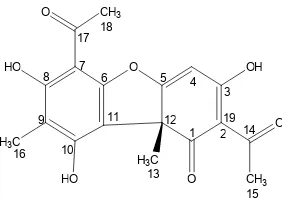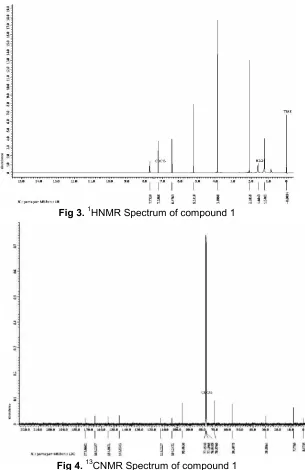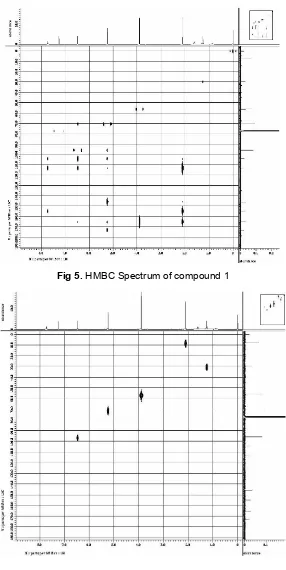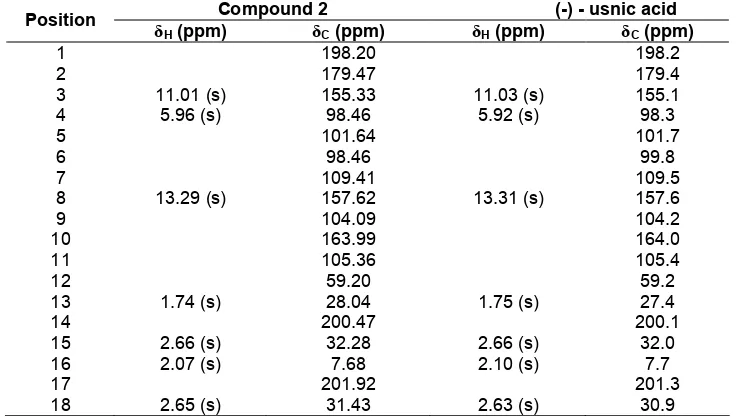CH3
A NEW PHENOLIC COMPOUND FROM ACETONE EXTRACT
OF LICHEN
Usnea flexuosa
Tayl.
Maulidiyah
1,*, A. Herry Cahyana
2, and Wahyudi Priyono Suwarso
2 1Department of Chemistry, Faculty of Mathematics and Science, Haluoleo University, Kampus Bumi Tridharma, Jl. H.E.A. Mokodompit, Anduonohu, Kendari 93232
2
Department of Chemistry, Faculty of Mathematics and Science, University of Indonesia, Depok, West Java 16424
Received June 10, 2011; Accepted July 12, 2011
ABSTRACT
Natural product, 2’-hydroxy-1’-(4-hydroxyl-5-methoxy-2-methyl-phenyl)-ethanon, (1), was isolated from the thalli lichen Usnea flexuosa Tayl. together with the known (-) - usnic acid (2). The structure of compounds 1 and 2 were determined by the spectroscopic studies.
Keywords:Usnea flexuosa Tayl., phenolic compound, lichen, (-) - usnic acid
INTRODUCTION
Lichen produces a wide range of organic compounds that can be divided into two groups: primary and secondary metabolites [1]. Primary metabolites are proteins, lipids, carbohydrates, and other organic compounds that are essential to the lichen’s metabolism and structure. Some of these metabolites are produced by the lichen fungi partner and other by the lichen’s algae or cyanobacterial partners. Secondary metabolites are produced by the fungi alone and secreted onto the surface of lichen’s hyphae either in amorphous or as crystal. If these substances are only found in lichen, then they are called lichen substances [2-3].
In spite of being described as a symbiotic association between the photosynthetic organism and fungi, lichens are highly complex communities that produce peculiar substances with phenolic characteristic such as the barbatic, usnic and furmaprotocetraric acid [4].
The presence of phenolic derivatives in lichen is determinant for its antimicrobial activity. These substances generally acidify the bacterial cell and consequently caused cytoplasm membrane rupture in the active site of the enzymes, and interfere on the electron transport process and in the oxidative phosphorylation [5-7].
More than 1.100 medicinal plants are found in Indonesia, but only 750 species show therapeutic effect in clinical trials [8]. Usnea flexuosa TayL, a species belonging to the fruticose lichen is used in traditional medicine in Indonesia against tuberculosis, allergenic and inflammatory.
Although the chemical composition of U. flexuosa Tayl. has not been investigated previously, we now
report the isolation and structure elucidation of a new phenolic compound, 2’-hydroxy-1’ -(4-hydroxyl-5-methoxy-2-methyl-phenyl)–ethanon (1) (Fig. 1), along with a dibenzofuran, (-) - usnic acid (2)(Fig. 2) from the thalli of this species.
EXPERIMENTAL SECTION
Materials
The thalli of lichenU. flexuosaTayl. was collected from Mount Bawakaraeng, South Sulawesi Province, Indonesia on August 2006, and identified at Herbarium Bogoriensis (Research Center for Biology, Indonesian Institute of Sciences, Bogor).
Fig 1.Structure of 2’-hydroxy-1’ -(4-hydroxyl-5-methoxy-2-methyl-phenyl)–ethanon
Fig 3.1HNMR Spectrum of compound 1
Fig 4.13CNMR Spectrum of compound 1
Instrumentation
The 1HNMR and 13CNMR spectra were recorded with CDCl3 at 500 MHz on Jeol USA JNM ECA-500 NMR spectrometer with TMS as internal standard. The LC-MS were recorded on a Mariner Biospectrometry. The IR spectra were recorded on a IR Prestige-21 Shimadzu 2450 spectrometer. The UV spectra were recorded on a Shimadzu UV-160 A spectrophotometer. The melting point was determined on a Buchi Melting point B-540 apparatus. Column Chromatography (CC) was carried on silica gel Column (70-230 mesh). Purity of the samples was checked by TLC on precoated silica
gel 60 F 254 preparative plates (20 x 20 cm, Merck) and were detected under UV light (254 nm and 366 nm), while posterior spray of H2SO4(10%) in methanol and heating at 100 °C, until spots color reaction.
Procedure
Extraction and Isolation
Fig 5.HMBC Spectrum of compound 1
Fig 6.HMQC Spectrum of compound 1
extract was obtained. The crude extract was subjected to column chromatography over silica gel with the column eluted successively with n-hexane-EtOAc mixtures of increasing polarity to afford four fractions.
2’-hydroxy-1’ -(4-hydroxyl-5-methoxy-2-methyl-phenyl)-ethanon (1): white amorphous solid; m.p. 136-137 °C; UV λmax(CH2Cl2)(log є) 235 nm and 260 nm; IR
(KBr) υ, cm-1
: 3680, 2924, 2854, 2546, 1759, 1604, 1519, 1442, 1365, 1249, 1195, 1041, 948, 833; LC-MS, m/z = 196; NMR data, see Table 1.
(-) - Usnic acid (2), yellow needles, m.p. 204 °C;
UV λmax(CH2Cl2)(log є) 233 nm and 281 nm; IR (KBr) υ,
cm-1: 3082, 2922, 2852, 1693, 1541, 1458, 1367, 1288, 1191, 1143;1HNMR (CDCl3)δH, ppm : 1.74 (3H,s); 2.07 (3H, s); 2.66 (3H, s); 5.96 (1H, s); 11,01 (1H, s); 13,29 (1H, s); 13CNMR (CDCl3) δC, ppm : 7.63; 28.04; 31.43; 32.28; 59.20; 98.46; 101.64, 104.09; 105.36; 109.41; 155.33; 157.62; 163.99; 179.47; 198.2; 200.47; 201.92.
RESULT AND DISCUSSION
2’-hydroxy-1’
-(4-hydroxyl-5-methoxy-2-methyl-phenyl)-ethanon (1) was obtained as a white amorphous solid. The LC-MS spectrum displayed the M+ at m/z = 196.26 (C10H12O4). The UV absorptions at 235 and 260 nm indicated the presence of a substituted benzene ring [9]. The IR spectrum showed absorption bands at 3435 (OH), 1728 (C=O), 1625, 1612 (aromatic C=C), 1471 (CH2) and 1369 (-CH3). The
1 HNMR spectrum of compound1 (Fig. 3) displayed signals for a methoxy group at δ 3.89 (s, -OCH3). Two aromatic methyn protons at δ 6.47 (s, 1H) and δ 7.73 (s, 1H), while atδ2.10 (s, 3H) indicated the presence of methyl group. In addition the1HNMR spectrum also exhibited a signal at δ 5.24 (s, 2H) for methylene group connective with hydroxyl. The13CNMR spectra (Fig. 4) showed the resonances of 10 carbons including a methyl carbon at 7.77 ppm, a methylene carbon at 70.5 ppm, two
methyne carbons at 96.8 ppm and 104.2 ppm, a methoxy carbon at 56.3 ppm and five quaternary carbons. A down field quaternary signal at 173.1 ppm was assigned to a ketonic functionality [10]. Four quaternary carbon signals at 145.8 (C-1), 113.2 (C-2), 154.8 (C-4) and 165.2 (C-5) ppm corresponding to C-1, C-2, C-4 and C-5 were also observed. In the HMBC spectrum (Fig. 5), methyl proton (δ2.10) showed2Jand 3
J correlations with C-2 and C-1, respectively, while the methoxy group (δ 3.89) was substituted at C-5 on the basis of its HMBC correlation with carbon signal at 165.2 ppm. The methylene proton (δ 5.24) showed 2J and 3J correlation with carbonyl carbon and C-1, respectively. The C-3 aromatic methyn proton (δ 6.47) showed HMBC correlation with C-2 and C-5. The C-6 aromatic methyn proton (δ7.73) correlation with C- and C-4. The1HNMR,13CNMR and 2D NMR spectra of (1) including HMQC (Fig. 6) and HMBC allowed the assignment of all proton and carbon signals (Table 1). These spectroscopic studies led to the structure (1) for this new phenolic derivate.
Table 1.1H,13CNMR and HMBC spectra data for (1) in
Table 2.The chemical shift spectra data comparison of1H-NMR and13C-NMR from M1and (-) - usnic acid
Compound 2 (-) - usnic acid
Compound (2) was isolated as a yellow prism crystal with the LC-MS displaying the M+at m/z (344.48), corresponding to the formula C18H16O7. This compound was previously isolates from lichens in genera Alectoria, Cladonia, Usnea, Lecanora, Ramalina and Evernia [11]. The chemical shift spectra data comparison of 1HNMR and13CNMR from compound (2) and (-) - usnic acid [12] can be seen in Table 2. The data show very similar. Therefore the compound (2) is (-) - usnic acid.
CONCLUSION
Two compounds of thalli lichen Usnea flexuosa Tayl has been isolated from aceton extract. The compounds have been identified as: 2’ hydroxy 1’ (4 -hydroxyl -5- methoxy -2- methyl - phenyl) - ethanon (1), and (-) - usnic acid (2). The structure of compounds (1) and (2) were determined by using the spectroscopic studies.
ACKNOWLEDGEMENT
We thank the Directorate General of Higher Education the Ministry of National Education for its financial support on Doctorate Research Grant.
REFERENCES
1. Ellix, J.A., 1996. Biochemistry and Secondary Metabolites. Cambridge University Press, Cambridge 154–181.
2. Ozturk, S., Guvenc, S., Anban, N., and Yalmaz, O., 1999,Lagascalia, 21, 47–52.
3. Turk, O.A., Meral, Y., Merih, K., and Hayrettin, T., 2003,Naturforsh, 58 C, 850–854.
4. Martins, M.C.B., Marcio, J.G., Flavia, P.S., Eulalia, A.X., Nicacio, H.S., and Eugenia, C.P., 2010. J. Braz. Arch. Biol. Technol., 53, 115–122.
5. Mueller, K., 2001, Appl. Microbiol. Biotechnol., 56, 9–16.
6. Randhir, R., Lin, Y.T., and Shetty, K., 2004. Proc. Biochem., 39, 637–646.
7. Vatten, D.A., Lin, Y.T., Lable, R.G., and Shetty, K., 2004,Innovative Food Sci. Emerg. Technol., 5, 81– 91.
8. Suwarso, W.P., Ratna, L.G., Karsten, and Markus, J., 1999,Eur. J. Org. Chem., 7, 1719–1721.
9. Hatjimanoli, M., Bonvin, J.F., Kaonadji, M., and Mariotte, A.M., 1988,J. Nat. Prod., 51, 977–980. 10. Ding, Y.L., and Jia, Z.J., 1992,Phytochemistry,31,
1435–1436.
11. Ingolfsdottir, K., 2002, Phytochemistry, 61, 729– 736.



